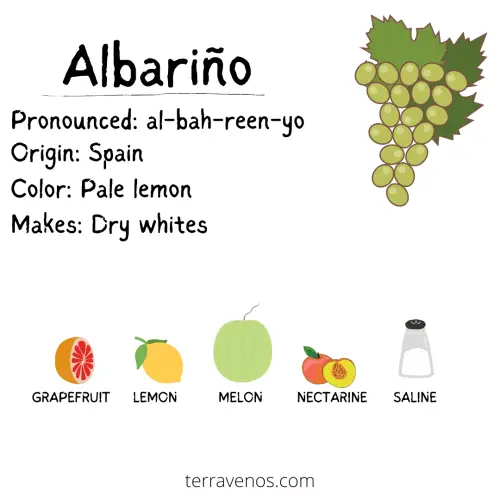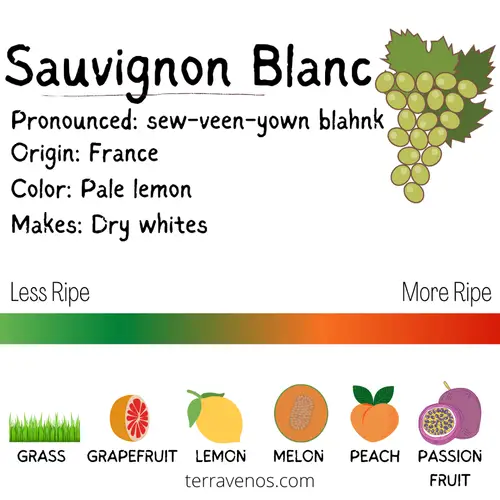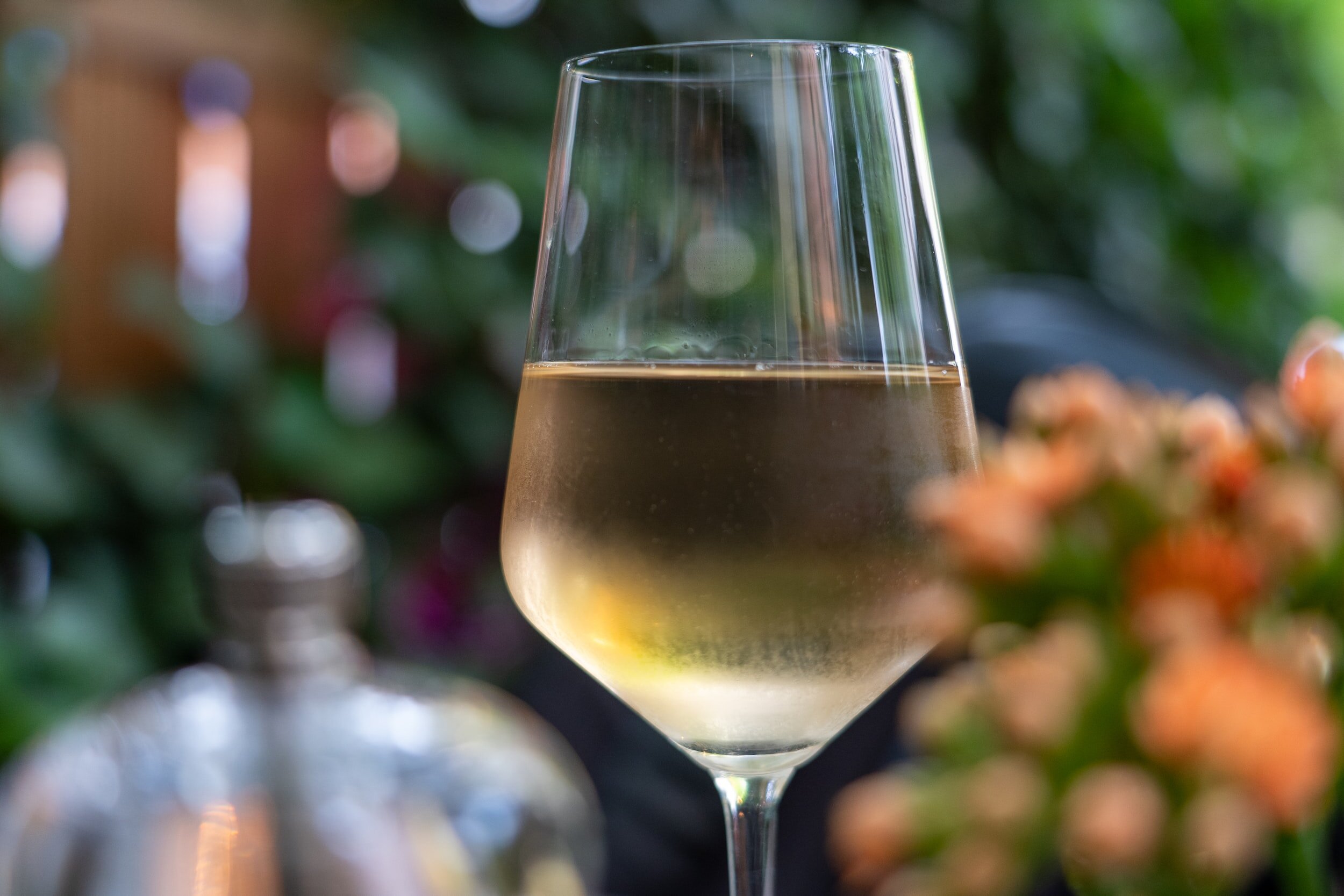| Characteristics | Albariño | Sancerre |
|---|---|---|
| Hue | Pale to medium lemon | Pale to medium lemon |
| Color | White | White |
| Aromas | Citrus, peach, apricot, saline | Green apple, gooseberry, mineral, stone fruit |
| Sweetness | Dry | Dry |
| Acid | High | High |
| Alcohol (%) | 11-13.5% | 12.5-14% |
| Body | Light to medium | Medium |
| Intensity | Medium to pronounced | Medium to Pronounced |
| Key Growing Regions | Spain (Rias Baixas), Portugal | Sancerre AOC, Loire Valley, France |
| Classic Pairings | Seafood, shellfish, light salads | Goat cheese, seafood, poultry |
| Price Range | $15-$30 | $25-$50+ |
Albariño vs Sancerre are logical wines to compare.
Both Albariño and Sancerre are high-acid, citrus-driven white wines. Sancerre is more aromatic with citrus, green, and mineral notes. Albariño has a saline note. Albariño is more widely available.
TL;DR: If you love Albariño, you’ll enjoy Sancerre.
Here’s what you need to know about the differences between Sancerre and Albariño.
- Albariño Basics: A Coastal Queen
- Sancerre: Energetic White Wine
- Contrasting Characteristics: Albariño vs. Sancerre
- Sancerre vs. Albariño Winemaking
- Sancerre vs. Albariño: Food Pairings and Serving Temperature
- Which Is More Expensive, Sancerre vs Albariño?
- Which Is Better? Sancerre vs Albariño
- Final Thoughts – Albarino vs Sancerre
Albariño Basics: A Coastal Queen

Albariño, a gem from Spain’s Rías Baixas region in Galicia, captures the essence of its maritime terroir. This zesty white wine boasts a vibrant acidity that enlivens the palate. Albariño embodies refreshing citrusy notes, accompanied by hints of floral elegance.
Its crisp and invigorating profile makes it a perfect companion for seafood dishes. Think oysters, fish and chips, ceviche, and more.
In Rías Baixas, where Albariño reigns supreme, the wine reflects the region’s coastal charm. The combination of cool ocean breezes and mineral-rich soils imparts a unique character to the grapes, resulting in wines that embody the spirit of the Galician coastline. Helpful Tip: Go check out this post for a deep dive into Albariño wine.
Fun Wine Fact: The name “Albariño” is derived from the word “Alba,” which means white in Galician, reflecting the grape’s light color.
Famed Albarino Winegrowing Regions:
- Rias Baixas, Spain
- Northern Portugal
- Coastal California
- Oregon
- New Zealand.
Sancerre: Energetic White Wine

Sancerre is 100% Sauvignon Blanc made in the Sancerre AOC region of Loire Valley, France. This is an intense, aromatic, high-acid white wine that’s gained an international reputation for quality.
Helpful Tip: Go check out other wines similar to Sancerre you should be drinking (also from the Loire Valley).
Fun Wine Fact: Sauvignon Blanc, Cabernet Sauvignon, and Cabernet Franc are all related and share that distinctive green grassy aroma.
Contrasting Characteristics: Albariño vs. Sancerre
When it comes to Albariño and Sancerre, these two white wines share several key characteristics.
Albariño Wine Profile
- Sweetness: Albariño wines tend to be dry, offering little to no residual sugar.
- Alcohol: Typically, Albariño wines have a moderate alcohol content, ranging from around 11% to 13% ABV.
- Body: Albariño wines generally have a medium body, providing a satisfying weight on the palate.
- Acid: Albariño is renowned for its vibrant acidity, which adds freshness and liveliness to the wine.
- Aroma and Intensity: Albariño boasts pronounced flavors and aromas, with a focus on citrus notes, especially lemon and lime.
- Flavors: In addition to citrus, Albariño often exhibits flavors of green apple, peach, apricot, and sometimes a hint of saline minerality.
Sancerre Wine Profile
- Sweetness: Sancerre is a dry white wine
- Alcohol: Sancerre has medium alcohol, in the 12%-14% range
- Body: Sancerre has a medium-bodied profile, offering a refreshing and zesty experience.
- Acid: Sancerre is a classic, high-acid white wine
- Aroma and Intensity: Sancerre almost always has an intense aroma profile with citrus, tree fruit, stone fruit, and gooseberry. Sancerre will have an herbal quality to it.
- Flavor: Vibrant flavors of citrus, herbal and mineral notes.
Is Albariño Similar to Sancerre?
Yes, Albarino and Sancerre taste similar. They share vibrant acidity and forefront citrus flavors, like lemon and lime. They both pair with lighter dishes and have refreshing acidity to complement seafood. If you enjoy Albariño, you’ll likely love Sancerre.
What Is the Difference Between Sancerre and Albariño Wine?
Albariño can also have saline notes thanks to coastal vineyards. Sancerre has a distinctive mineral note along with grassy and gooseberry flavors.
Sancerre vs. Albariño Winemaking

Both Sancerre and Albariño go through protective winemaking to minimize oxidation and maximize freshness. This means using stainless steel and temperature-controlled fermentation.
Fun Fact: Sancerre and Albariño wines are rarely blended with other types of grapes. They’re what we call “single varietal” wines.
Sancerre vs. Albariño: Food Pairings and Serving Temperature

When it comes to food pairings, Albariño and Sancerre work well with similar cuisine. Their zesty acidity and citrus notes make them a perfect match for coastal seafood dishes, shellfish, and light salads. The wines’ acid compliments these dishes and naturally accentuates their flavors with a refreshing touch.
Helpful Tip: If you’re just getting started with wine, head over to the post that covers just the basics of food and wine pairing.
Both Albariño and Sancerre are best enjoyed chilled. Stick them in the refrigerator overnight or at the very least a few hours before drinking.
Helpful Tip: Ever get confused with recommended serving temperatures? Here’s a breakdown of wine serving temperatures and different wine styles and how you can use them in real life.
Which Is More Expensive, Sancerre vs Albariño?

When comparing the prices of Sancerre and Albariño, it’s natural to wonder which one is more expensive considering they’re similar styles. Let’s break it down:
Wine Prices and Quality Levels
| Quality Level | Sancerre | Albariño |
|---|---|---|
| Entry-level | $25-$35 | $12 – $20 |
| Premium | $40 – $50+ | $25 – $50+ |
How Much Does Sancerre Cost?
- Entry-level Sancerre wines will cost around $25 USD.
- If you’re looking to treat yourself to a premium experience, you can find higher-priced Sancerre starting around $45 USD.
Helpful Wine Buying Tip: Sancerre wines can only come from Sancerre AOC in the Loire Valley, France. They’re not as widely grown or available as Albariño, meaning you’re going to pay more for them.
How Much Does Albariño Cost?
- Entry-level Albariño wines also come at accessible prices, usually falling within the $12 to $20 range per bottle. These wines are known for their vibrant acidity and refreshing characteristics, making them versatile for casual sipping or food pairing.
- On the premium side, Albariño reveals its elegance and expressive flavors. Premium Albariño wines, sourced from renowned regions, can be priced from $25 to $50 or even higher, delivering a memorable drinking experience.
Helpful Tip: Albariño is definitely a wine you’ll find at your local grocery store. Check out this post for 9 quick tips on how to buy great grocery store wines.
Which Is Better? Sancerre vs Albariño
If you want a high-acid white wine with linear citrus, green, and mineral notes, then Sancerre is better. If you want a high-acid white wine with a saline note, then Albariño is better. If price is your main concern, then Albariño is the less expensive option and a better choice.
Final Thoughts – Albarino vs Sancerre
Albariño and Sancerre are similar white wines that need to be enjoyed side-by-side. They both deliver that vibrant intensity that many white wine lovers enjoy. If you love Albariño, then you’ll enjoy Sancerre.
Personal Note: When I want a high acid, clean white wine, I usually pick Albariño. I’ll drink Sancerre on special occasions. It costs more, so I’m more deliberate about opening bottles of Sancerre.
Thirsty for More?
Discover More:
Pinot Grigio vs Vermentino
Sauvignon Blanc vs Pinot Grigio
Pinot Grigio vs Pinot Blanc




